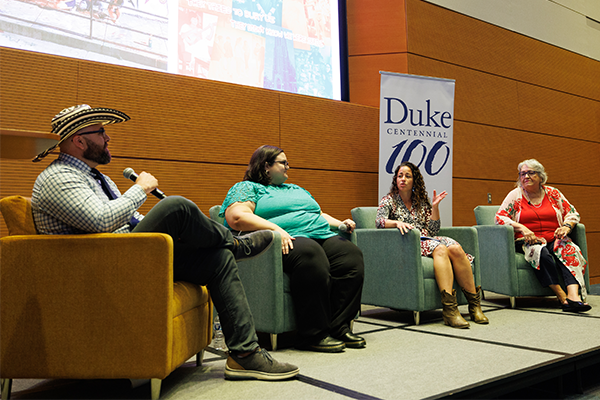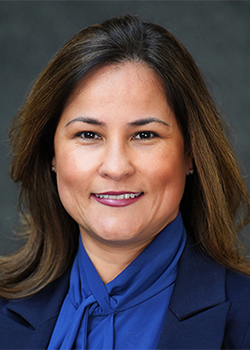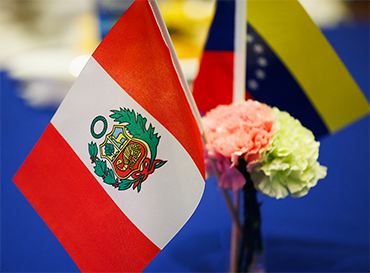
At Duke University School of Medicine’s annual ¡DALHE! Hispanic Heritage Month event, attendees came together to reflect on the often-overlooked history of Latinos in the South.
"This year’s theme for the national Hispanic Heritage month is “Pioneers of Change: Shaping the Future Together," and with Duke celebrating its Centennial, there’s no better time to honor the contributions of Latinos at Duke and look forward to the future we’re shaping together," said Raquel Ruiz, MBA, co-director of the Equity, Learning Health Communities Pillar at the Clinical and Translational Science Institute (CTSI).

The ¡DALHE! Employee Resource Group engages the community, supports arts and culture and organizes "Virtual Cafecitos," providing a space for Duke Latiné/Hispanic staff and allies to grow and connect, and during its Sept. 16 heritage month event “Pasado & Perspectiva: Past and Present,” explored Latino contributions and identity in the region.
A panel discussion featured Duke historian Cecilia Márquez, PhD, Duke School of Nursing Associate Professor Rosa Gonzalez-Guarda, RN,PhD, MPH, and consultant Norma Martí. Moderated by Fernando Orozco, MBA, the panel highlighted the complexities of Latino identities, migration stigma, protecting Latino health and the lasting impact of Latino students, faculty, and staff on Duke's history and legacy.
Evolution of Latino Activism at Duke
In her keynote address, Márquez, Hunt Family assistant professor in history at Duke University, opened her talk by addressing the gaps in public knowledge about Latinos in Southern history.
“If you learned anything about Latino history in school, you probably learned about Cesar Chavez, Dolores Huerta. But mostly, it’s about California, maybe New York if you’re on the East Coast,” she said. “We really don’t have a sense of the history of Latinos here in the South. That’s what I set out to uncover.”
Drawing from her book, Making the Latino South, which traces the stories of Latinos from the 1940s to the 2010s, Márquez highlighted stories like that of the Soto family, who moved from Texas to Mississippi in the 1950s. The family found a surprising level of racial acceptance in Mississippi despite its segregationist laws, illustrating how Latinos in the South occupied a unique racial space, seen as neither Black nor fully white.
Márquez also delved into Duke University’s own Latino history, much of which has been hidden in plain sight.
“So how do we tell the history of Latino students here at Duke? Does it begin with Jose Portilla, the first known Latino student at Duke, who came from San Juan, Puerto Rico, in 1913 along with the arrival of international students in the 1910s? Or does it start with the activism of the 1960s and ’70s, when Latino students began to organize and advocate for their rights on campus?”
Portilla, a member of the physics and science clubs, was one of only a handful of international students at Duke during his time. “Like others classified as white, he had a different experience, though he would not have been able to escape the racial hierarchies of the segregated South. Unfortunately, he didn’t graduate—he was dismissed after a hazing incident in 1917,” Márquez shared.
It would be nearly 30 years later in 1942, that Duke would enroll Nora Elisa Recio, the first known Latina student at Duke.
“It’s common to hear Latino historians insist that Latino history is American history. It’s not an addendum or a subset—it’s central to the American story. And today, I hope that the work I’ve shared demonstrates that this truth extends here, to Duke. Duke’s history is Latino history.”
- Cecilia Márquez, PhD, Duke historian
“Nora presided over Tau Psi Omega, a fraternity dedicated to the study of language and culture, but she didn’t feel entirely welcome. She described herself as a ‘specimen,’ a curiosity to her classmates,” Márquez said. Nora later wrote, “Although I realized their questions were a way of expressing interest in my country’s customs and ideals, they bothered me to no end.”
The story of Latino students at Duke shifted dramatically after the 1969 Allen Building takeover, an act of Black student activism demanding more equitable conditions for minorities on campus.
“The takeover paved the way for Latino students to have a more visible presence at Duke,” Márquez emphasized. One such student was Reginaldo ‘Reggie’ Howard, whose parents immigrated from Panama to South Carolina. In 1976, Howard became Duke’s first Black student body president. His legacy endures in the Reginaldo Howard Memorial Scholars program.
“By the 1980s, Latino students had formed organizations and initiated their own activism, pushing for social justice on campus,” Márquez said. “Their efforts transformed Duke—leading to the recruitment of more Latino students, the hiring of Latino faculty, and, eventually, a change in Duke’s admissions policy to accept undocumented students.”
Márquez closed her presentation by addressing the continued importance of this history.
“It’s common to hear Latino historians insist that Latino history is American history. It’s not an addendum or a subset—it’s central to the American story. And today, I hope that the work I’ve shared demonstrates that this truth extends here, to Duke,” she concluded. “Duke’s history is Latino history.”
Facing Economic and Health Challenges with Resilience
The panel also tackled the ongoing health and socioeconomic challenges faced by the Latino community. They discussed the rollback of affirmative action programs, which threatens to worsen the disconnect between Latino students and faculty, as well as misconceptions that Latinos come to the U.S. seeking handouts.
The reality is much more complex and rooted in active recruitment by Southern industries such as manufacturers and poultry factories. The wave of labor migration is driven by the demand for cheap, reliable labor and Latinos are actively recruited to fill the gap.

“Latinos don’t just appear – they’re invited, they’re recruited and they’re contributing to the economy in ways that often go unnoticed,” the historian said.
Gonzalez-Guarda, a nurse scientist focused on Latino health in North Carolina, raised concerns about the slow recovery of Latino working parents, especially those aged 30 to 45, who have struggled in the aftermath of the pandemic.
“Historically, Hispanics have had a health advantage, but in recent years, we’ve seen that advantage erode, with the greater decline in life expectancy than any other racial or ethnic group in the US,” she noted.
There are strategies to help maintain resilience: her research highlights the importance of cultural and family ties as protective factors that can improve health outcomes.
Martí, a retiree of the North Carolina Department of Health and Human Services, shared her joy at seeing the group gathered to celebrate the Hispanic culture and community. She continues to support Hispanic families through meditation classes and by advocating for inclusive clinical studies that provide translation services.
“Thank you to all who shine a light for others to see,” she said, closing the event on a note of gratitude and hope for the future.
Photos by Eamon Queeney, assistant director of multimedia and creative